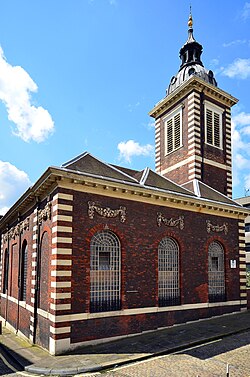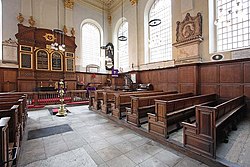St Benet's, Paul's Wharf
| St Benet Paul's Wharf | |
|
London, Middlesex | |
|---|---|

| |
| Church of England | |
| Diocese of London | |
| Location | |
| Location: | 51°30’42"N, 0°5’57"W |
| History | |
| Baroque | |
| Information | |
| Website: | stbenetwelshchurch.org.uk |
The Church of St Benet Paul's Wharf is Church of England church in the City of London, Middlesex. St Benet’s is known as the Welsh church, and to this day it holds services of worship in the Welsh language. This has been the case since 1879, when Queen Victoria saved the church from threatened redundancy by granting St Benet’s the right to hold Welsh services in perpetuity, as it still does each Sunday morning.
Since 1556, St Benet’s has also been the official church of the College of Arms, and many officers of arms have been buried here.
In 1666 the church was destroyed in the Great Fire of London, after which it was rebuilt and merged with nearby St Peter, Paul's Wharf. The current church was designed by Sir Christopher Wren.[1] It is one of only four churches in the City of London to escape damage during the Second World War.
History
St Benet's traces its history back to the year 1111, when a church was built on the site and dedicated to St Benedict. Over time the name was abbreviated to St Benet. To the west of the site was the watergate of Baynard's Castle, which is referenced in the biographies of Queen Anne Boleyn and Lady Jane Grey. Both the church and the castle were destroyed in the Great Fire of London in 1666. It was rebuilt by the architect Christopher Wren, and reopened in 1683.
On 2 March 1706, Henrietta Hobart married Charles Howard, 9th Earl of Suffolk, a captain in the 6th (Inniskilling) Dragoons there. Henrietta subsequently became mistress to the future King George II.)[2][3]
The church was narrowly saved from destruction in the late 19th century, when its parish was merged with that of St Nicholas Cole Abbey. After an energetic campaign by its supporters, Queen Victoria in 1879 granted the church to Welsh Anglicans for services. St Benet's continues as London's Metropolitan Welsh church, with its services conducted in the Welsh language, and with English translation provided.[4]
Present day
In 2008 the church was closed for a few months due to a "dwindling congregation"[5] but reopened in time for the carol service in December that year. Services are held weekly on Sunday mornings at 11am, with occasional special services on Sunday afternoons at 3pm.[6] The church can be toured on Thursdays between 11am and 3pm.
Exterior
The church is of dark red brick, with alternating courses of Portland stone at the corners. The tower is situated to the north-west of the nave and is capped by a small lead dome, lantern and simple short spire.[7]
Interior

The interior is almost a square. Unusually for a Wren church, the ceiling is flat rather than domed or barrel-vaulted. The north gallery was formerly used by the Doctors' Commons, and is now used by the College of Arms. Most of the original 17th-century furnishings are still intact, including the magnificent communion table, reredos and pulpit, designed by Grinling Gibbons. The lectern and font are also original.[8]
The galleries are supported by Corinthian columns. There is a memorial to Inigo Jones, who was buried in the previous church,[9] and a medallion bust of Sir Robert Wyseman, a benefactor of St Benet's who died in 1684.[7]
Outside links
| ("Wikimedia Commons" has material about St Benet's, Paul's Wharf) |
References
- ↑ Christopher Hibbert, Ben Weinreb et al, The London Encyclopaedia, 3rd ed. (London: Pan Macmillan, 2008); ISBN 978-1-4050-4924-5
- ↑ Tracy Borman, King's Mistress, Queen's Servant: The Life and Times of Henrietta Howard (London: Vintage, 2010), p. 17.
- ↑ [2]
- ↑ "St Benet The Metropolitan Welsh Church: Services". http://www.stbenetwelshchurch.org.uk/pages/worshipENG.html. Retrieved 18 May 2014.
- ↑ "Welsh church in London is closed". BBC News. http://news.bbc.co.uk/2/hi/uk_news/wales/7513957.stm. Retrieved 17 May 2015.
- ↑ "St Benet The Metropolitan Welsh Church: Diary". http://www.stbenetwelshchurch.org.uk/pages/diaryENG.html. Retrieved 1 Sep 2016.
- ↑ 7.0 7.1 Weinreb, Ben; Hibbert, Christopher: ‘The London Encyclopaedia’ (Macmillan, 1992) page 717
- ↑ Bradley, Simon and Pevsner, Nikolaus (1998). London – The City Churches (reprint ed.). Penguin Books. p. 70.
- ↑ "The City Churches" Tabor, M. p66:London; The Swarthmore Press Ltd; 1917
